荧光灯使用说明
节能灯说明
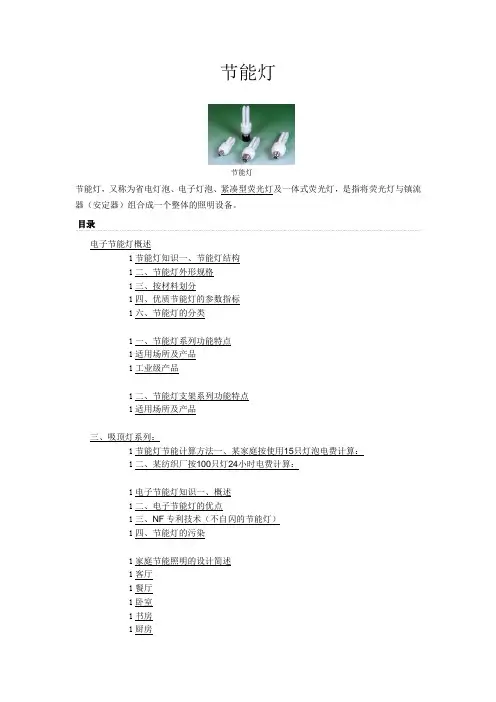
节能灯节能灯节能灯,又称为省电灯泡、电子灯泡、紧凑型荧光灯及一体式荧光灯,是指将荧光灯与镇流器(安定器)组合成一个整体的照明设备。
目录电子节能灯概述1节能灯知识一、节能灯结构1二、节能灯外形规格1三、按材料划分1四、优质节能灯的参数指标1六、节能灯的分类1一、节能灯系列功能特点1适用场所及产品1工业级产品1二、节能灯支架系列功能特点1适用场所及产品三、吸顶灯系列:1节能灯节能计算方法一、某家庭按使用15只灯泡电费计算:1二、某纺织厂按100只灯24小时电费计算:1电子节能灯知识一、概述1二、电子节能灯的优点1三、NF专利技术(不自闪的节能灯)1四、节能灯的污染1家庭节能照明的设计简述1客厅1餐厅1卧室1书房1厨房家用节能灯选购的三大基本原则LED节能灯介绍节能灯电子节能灯概述电子节能灯,又称为省电灯泡、电子灯泡、紧凑型荧光灯及一体式荧光灯,是指将荧光灯与镇流器(安定器)组合成一个整体的照明设备。
节能灯的尺寸与白炽灯相近,与灯座的接口也和白炽灯相同,所以可以直接替换白炽灯。
节能灯的正式名称是稀土三基色紧凑型荧光灯,20世纪70年代诞生于荷兰的飞利浦公司。
被国家纳入到了863推广计划,最早在山东的胶东半岛推广,其中最早响应的两家工厂为威海北洋和栖霞灯具厂,但是由于早期成本比较高,推广难度比较大。
广东依靠其优越的地理位置,依托国家的政策支持,以低成本的原材料大批量生产节能灯,并销往全国。
因为早期人们对于节能灯的概念比较模糊,广东生产的卤粉节能灯成本较低,销往市场的价格也比较低,现全国80%的节能灯来自广东生产,其中80%的节能灯是在中山古镇生产的。
这种光源在达到同样光能输出的前提下,只需耗费普通白炽灯用电量的1/5至1/4,从而可以节约大量的照明电能和费用,因此被称为节能灯。
节能灯知识一、节能灯结构主要是由“上部灯头结构”以及“底部灯管结构”组成;在该结合结构的内部包设一节能电子镇流器组成;其特征是在上结合结构部与节能电子镇流器的空间下方,增设一隔板结构;而在下结合结构部设一增长区段空腔结构;并在该段增长空腔结构外壁周围,环设多数个通孔,用于多元隔热、分流、散热、确保节能灯正常使用寿命。
日光灯工作原理
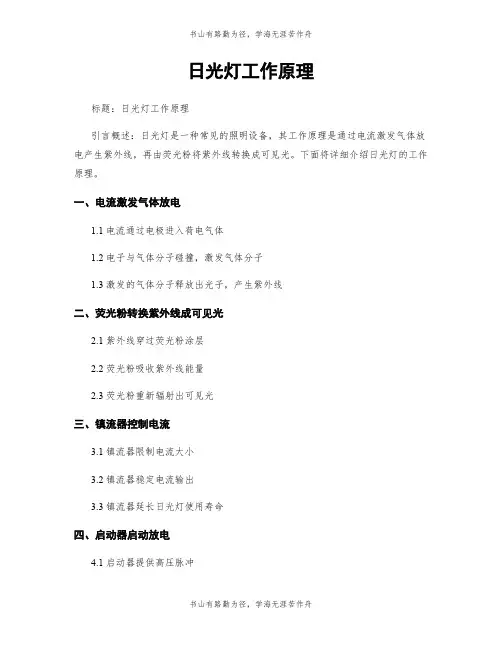
日光灯工作原理
标题:日光灯工作原理
引言概述:日光灯是一种常见的照明设备,其工作原理是通过电流激发气体放电产生紫外线,再由荧光粉将紫外线转换成可见光。
下面将详细介绍日光灯的工作原理。
一、电流激发气体放电
1.1 电流通过电极进入荷电气体
1.2 电子与气体分子碰撞,激发气体分子
1.3 激发的气体分子释放出光子,产生紫外线
二、荧光粉转换紫外线成可见光
2.1 紫外线穿过荧光粉涂层
2.2 荧光粉吸收紫外线能量
2.3 荧光粉重新辐射出可见光
三、镇流器控制电流
3.1 镇流器限制电流大小
3.2 镇流器稳定电流输出
3.3 镇流器延长日光灯使用寿命
四、启动器启动放电
4.1 启动器提供高压脉冲
4.2 高压脉冲使气体放电
4.3 日光灯开始发光
五、日光灯的优点
5.1 节能环保,比传统白炽灯更省电
5.2 光线柔和,不易炫目
5.3 使用寿命长,可达数千小时
结论:日光灯通过电流激发气体放电产生紫外线,再由荧光粉转换成可见光的工作原理,具有节能环保、光线柔和和使用寿命长等优点,是一种理想的照明设备。
日光灯工作原理
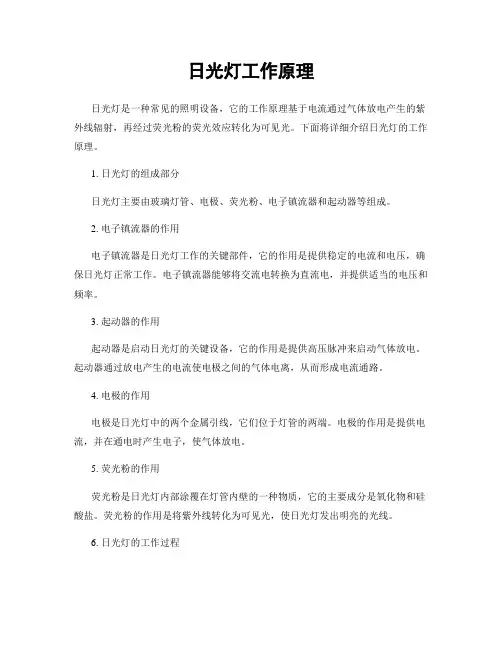
日光灯工作原理日光灯是一种常见的照明设备,它的工作原理基于电流通过气体放电产生的紫外线辐射,再经过荧光粉的荧光效应转化为可见光。
下面将详细介绍日光灯的工作原理。
1. 日光灯的组成部分日光灯主要由玻璃灯管、电极、荧光粉、电子镇流器和起动器等组成。
2. 电子镇流器的作用电子镇流器是日光灯工作的关键部件,它的作用是提供稳定的电流和电压,确保日光灯正常工作。
电子镇流器能够将交流电转换为直流电,并提供适当的电压和频率。
3. 起动器的作用起动器是启动日光灯的关键设备,它的作用是提供高压脉冲来启动气体放电。
起动器通过放电产生的电流使电极之间的气体电离,从而形成电流通路。
4. 电极的作用电极是日光灯中的两个金属引线,它们位于灯管的两端。
电极的作用是提供电流,并在通电时产生电子,使气体放电。
5. 荧光粉的作用荧光粉是日光灯内部涂覆在灯管内壁的一种物质,它的主要成分是氧化物和硅酸盐。
荧光粉的作用是将紫外线转化为可见光,使日光灯发出明亮的光线。
6. 日光灯的工作过程当日光灯通电时,电子镇流器提供稳定的电流和电压。
起动器产生高压脉冲,使电极之间的气体电离,形成电流通路。
电流通过气体放电时产生紫外线辐射,紫外线经过灯管内壁的荧光粉时被荧光粉吸收并转化为可见光。
7. 日光灯的优势与传统的白炽灯相比,日光灯具有以下优势:- 节能:日光灯的能效比较高,能够节省电能消耗。
- 寿命长:日光灯的寿命一般比白炽灯长,可以减少更换灯泡的频率。
- 光线柔和:日光灯发出的光线柔和,没有明显的闪烁,不会对眼睛造成刺激。
- 色温可调:通过选择不同的荧光粉,可以调整日光灯的色温,满足不同场景的需求。
总结:日光灯是一种利用气体放电和荧光粉的光源,其工作原理是电流通过气体放电产生紫外线辐射,再经过荧光粉的荧光效应转化为可见光。
日光灯具有节能、寿命长、光线柔和等优势,是一种常见的照明设备。
荧光灯的安装及功率因数的提高
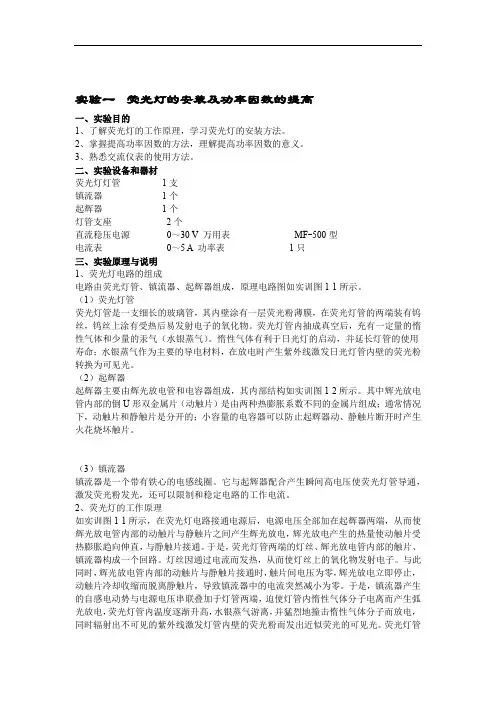
实验一荧光灯的安装及功率因数的提高一、实验目的1、了解荧光灯的工作原理,学习荧光灯的安装方法。
2、掌握提高功率因数的方法,理解提高功率因数的意义。
3、熟悉交流仪表的使用方法。
二、实验设备和器材荧光灯灯管1支镇流器1个起辉器1个灯管支座2个直流稳压电源0~30 V 万用表MF-500型电流表0~5 A 功率表1只三、实验原理与说明1、荧光灯电路的组成电路由荧光灯管、镇流器、起辉器组成,原理电路图如实训图1-1所示。
(1)荧光灯管荧光灯管是一支细长的玻璃管,其内壁涂有一层荧光粉薄膜,在荧光灯管的两端装有钨丝,钨丝上涂有受热后易发射电子的氧化物。
荧光灯管内抽成真空后,充有一定量的惰性气体和少量的汞气(水银蒸气)。
惰性气体有利于日光灯的启动,并延长灯管的使用寿命;水银蒸气作为主要的导电材料,在放电时产生紫外线激发日光灯管内壁的荧光粉转换为可见光。
(2)起辉器起辉器主要由辉光放电管和电容器组成,其内部结构如实训图1-2所示。
其中辉光放电管内部的倒U形双金属片(动触片)是由两种热膨胀系数不同的金属片组成;通常情况下,动触片和静触片是分开的;小容量的电容器可以防止起辉器动、静触片断开时产生火花烧坏触片。
(3)镇流器镇流器是一个带有铁心的电感线圈。
它与起辉器配合产生瞬间高电压使荧光灯管导通,激发荧光粉发光,还可以限制和稳定电路的工作电流。
2、荧光灯的工作原理如实训图1-1所示,在荧光灯电路接通电源后,电源电压全部加在起辉器两端,从而使辉光放电管内部的动触片与静触片之间产生辉光放电,辉光放电产生的热量使动触片受热膨胀趋向伸直,与静触片接通。
于是,荧光灯管两端的灯丝、辉光放电管内部的触片、镇流器构成一个回路。
灯丝因通过电流而发热,从而使灯丝上的氧化物发射电子。
与此同时,辉光放电管内部的动触片与静触片接通时,触片间电压为零,辉光放电立即停止,动触片冷却收缩而脱离静触片,导致镇流器中的电流突然减小为零。
于是,镇流器产生的自感电动势与电源电压串联叠加于灯管两端,迫使灯管内惰性气体分子电离而产生弧光放电,荧光灯管内温度逐渐升高,水银蒸气游离,并猛烈地撞击惰性气体分子而放电,同时辐射出不可见的紫外线激发灯管内壁的荧光粉而发出近似荧光的可见光。
台灯使用说明
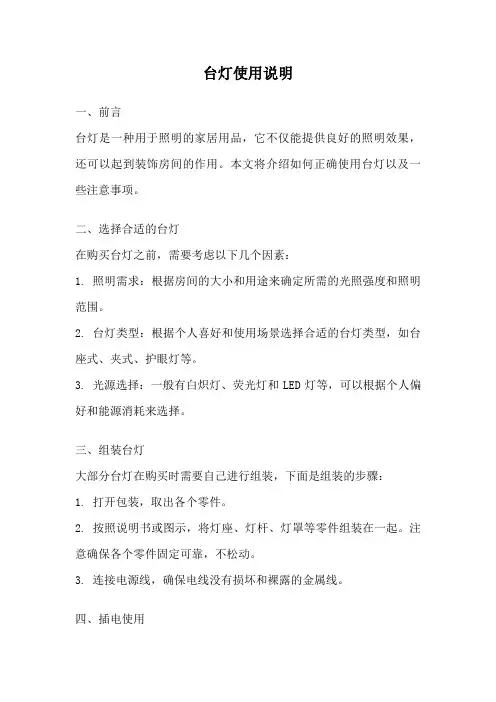
台灯使用说明一、前言台灯是一种用于照明的家居用品,它不仅能提供良好的照明效果,还可以起到装饰房间的作用。
本文将介绍如何正确使用台灯以及一些注意事项。
二、选择合适的台灯在购买台灯之前,需要考虑以下几个因素:1. 照明需求:根据房间的大小和用途来确定所需的光照强度和照明范围。
2. 台灯类型:根据个人喜好和使用场景选择合适的台灯类型,如台座式、夹式、护眼灯等。
3. 光源选择:一般有白炽灯、荧光灯和LED灯等,可以根据个人偏好和能源消耗来选择。
三、组装台灯大部分台灯在购买时需要自己进行组装,下面是组装的步骤:1. 打开包装,取出各个零件。
2. 按照说明书或图示,将灯座、灯杆、灯罩等零件组装在一起。
注意确保各个零件固定可靠,不松动。
3. 连接电源线,确保电线没有损坏和裸露的金属线。
四、插电使用在插电使用台灯之前,需要注意以下几点:1. 检查电源线是否连接稳固,不要有裸露的金属线。
2. 将插头正确插入墙壁插座,确保插头与插座的接触良好。
3. 避免将多个电器插头插入同一个插座,以免超负荷使用。
五、灯光调节大部分台灯都具备灯光调节功能,可以根据个人需求调整亮度和色温。
1. 亮度调节:通过台灯上的开关或旋钮来调节灯光的亮度,根据需要选择合适的亮度。
2. 色温调节:一些台灯支持调节色温,例如从白天模式切换到夜晚模式,以提供更适宜的照明环境。
六、注意事项在使用台灯时,需要注意以下几点:1. 使用环境:台灯应放置在平稳的台面上,避免在不稳定的位置使用,以免发生倾倒或摔落。
2. 使用时间:长时间使用台灯时,应适当休息眼睛,避免眼睛疲劳。
3. 防触电:不要用湿手触摸开关或插头,以免触电事故发生。
4. 避免长时间照射:长时间直视台灯灯光可能对眼睛造成伤害,应适当调整台灯的位置或使用时间。
5. 定期清洁:台灯需要定期清洁,可以用柔软的布擦拭灯罩和灯座,避免积灰影响照明效果。
七、节能环保为了节约能源和保护环境,我们在使用台灯时可以做到以下几点:1. 合理使用:根据需要使用台灯,避免长时间无人使用浪费电能。
ANSI C78.5-2003 自整流紧凑型荧光灯性能说明
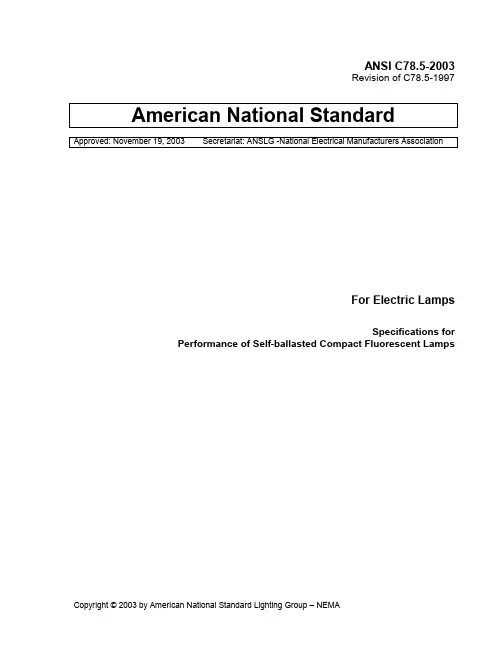
ANSI C78.5-2003Revision of C78.5-1997 American National StandardApproved: November 19, 2003 Secretariat: ANSLG -National Electrical Manufacturers AssociationFor Electric LampsSpecifications forPerformance of Self-ballasted Compact Fluorescent LampsAmerican National Standard Approval of an American National Standard requires verification by ANSI that the requirements for due process, consensus, and other criteria for approval have been met by the standards developer. An American National Standard implies a consensus of those substantially concerned with its scope and provisions. Consensus is established when, in the judgment of the ANSI Board of Standards Review, substantial agreement has been reached by directly and materially affected interests. Substantial agreement means much more than a simple majority, but not necessarily unanimity. Consensus requires that all views and objections be considered, and that a concerted effort be made toward their resolution. The existence of an American National Standard does not in any respect preclude anyone, whether s/he has approved the standard or not, from manufacturing, marketing, purchasing, or using products, processes, or procedures not conforming to the standards. It is intended as a guide to aid the manufacturer, the consumer, and the general public.The American National Standards Institute does not develop standards and will in no circumstances give an interpretation of any American National Standard. Moreover, no person shall have the right or authority to issue an interpretation of an American National Standard in the name of the American National Standards Institute. Requests for interpretations should be addressed to the Committee Secretariat referred to on the title page.CAUTION NOTICE: This American National Standard may be revised or withdrawn at any time. The procedures of the American National Standards Institute require that action be taken periodically to reaffirm, revise, or withdraw this standard. Purchasers of American National Standards may receive current information on all standards by calling or writing the American National Standards Institute.Printed and distributed by:Information Handling Services/Global Engineering Documents 15 Inverness Way East, Englewood, CO 80112-5776Under Contract with National Electrical Manufacturers AssociationCopyright Ó2003 by American National Standard Lighting Group In Affiliation with National Electrical Manufacturers Association All rights reserved.No part of this publication may be reproduced in any form,in an electronic retrieval system or otherwise, withoutprior written permission of the publisher.Printed in the United States of AmericaForeword (This foreword is not part of American National Standard C78.5-2003)Suggestions for improvement of this standard should be submitted to the Secretariat C78, American National Standard Lighting Group (NEMA), 1300 North 17th Street, Suite 1847, Rosslyn, VA 22209.This standard was processed and approved by Accredited Standards Committee on Electric Lamps, C78, and its Sub-Committee, C78 WG 02. Committee approval of the standard does not necessarily imply that all committee members voted for that approval.Information concerning approval of this standard is based on the documents listed in the table below.Amendment / Change CDV RVRevision CDV C78(2)/4133 RV C78(2)/4134David Mullen, Chairman, C78David Mullen, Technical CoordinatorRandolph N. Roy, SecretariatMatthew C. Clark, Coordinating EditorTable of ContentsForeword5I. ScopeReferences 5 2. Normative6 3. DefinitionsGeneral 6 3.1maintenance 6 3.2Lumentemperatures 6 3.3Starting4. Requirements 64.1General 64.2 Marking 6markings 64.3Other6interference4.4Electro-magneticindex 7 rendering4.5Color7power4.6Input7timeStarting4.77time4.8Run-upLuminousflux 74.9maintenance 7 Lumen4.104.11 Efficacy 7Lifetest 74.12Powerquality 74.134.14 Lamp current operating frequency 7requirements 8 transient4.15Linespecimens 8 test5. Selectionof6. Tests 8General 8 6.1Supply 8 Power6.2Instruments 8 Electrical6.36.4 Lifetest 8Annex A (Informative) Guidance for the measurementof lamp starting time9Bibliography 10 (Informative)BAnnexSpecifications for Performance of Self-ballasted Compact Fluorescent Lamps1. ScopeThis standard specifies the performance requirements together with the test methods and conditions required to show compliance of self-ballasted compact fluorescent lamps up to 60 watts which are intended for domestic and similar general lighting purposes. Globe and reflector types are excluded. Such lamps shall have a rated input voltage of 120 or 127 volts at 60 Hz and an Edison screw base.2. Normative ReferencesThe following publications contain provisions which, through reference in this text, constitute provisions of this American National Standard. At the time of publication, the editions indicated were valid. All standards are subject to revision, and parties to agreements based on this American National Standard are encouraged to investigate the possibility of applying the most recent editions of the publications indicated below.ANSI C78.375-1997, Fluorescent lamps - Guide for Electrical MeasurementsCIE Publication 13.3-1995, Second edition, Method of measuring and specifying color rendering index of light sourcesCIE Publication 15.2 (1986), ColorimetryIESNA LM-65-2001, Approved method for Lifetesting of Compact Fluorescent LampsIESNA LM-66-2000, Approved method for the Electrical and Photometric Measurements of Single-ended Compact Fluorescent LampsUL 1993-1993, Standard for Self-Ballasted Lamps and Lamp AdaptersANSI C82.13-2002, Definitions – for fluorescent lamps and ballastsANSI C82.77-2002, Harmonic emission limits – related power quality requirements for lighting equipment3. Definitions3.1 GeneralSee ANSI C82.13 for related definitions. Any standards referenced in those definitions should be considered as normative for the standard. Other definitions used in this standard follow.3.2 Lumen maintenanceThe luminous flux at a given time in the life of the lamp and expressed as a percentage of the initial luminous flux. The mean lumens are the value at 40% of rated life.temperatures3.3 StartingThe minimum and maximum temperatures at which the lamp will reliably start.4. Requirements4.1 GeneralSelf-ballasted compact fluorescent lamps shall be so constructed that, in normal use, they are without danger to the user and the general surroundings.Electrical and photometric performance of compact fluorescent lamps can be appreciably affected by drafts, ambient temperature, and burning position. For proper measurements of these characteristics, the requirements of clause 4, Ambient conditions, and clause 8, Lamp stabilization, in ANSI C78.375 must be met. Photometric procedures are covered under clauses 9,10, and 11 of IESNA LM-66. The lamps shall be stabilized base-up at 25o C.4.2 MarkingThe unit shall be marked in accordance with clause 27 of UL1993, Standard for safety, Self-ballasted Lamps and Lamp Adaptors.4.3 Other markings4.3.1The unit shall include instructions per clause 28 of UL1993 if so required.4.3.2 A warning regarding possible interaction with IR remote controls may be needed on the packaging of some units.4.3.3If the luminous flux in other burning positions varies by more than 5% from the rated position it shall be marked on the packaging.interference4.4 Electro-magneticUnits with electronic high frequency circuits shall comply with FCC regulations, Title 47 of the US Code of Federal Regulations, Part 18 for Consumer equipment. For units with electronic high frequency circuits operating below 1.705 MHz, radiated measurements shall be made from 30 to 200 MHz and be under the limits specified in FCC Part 18.305c.4.5 Color rendering indexSelf-ballasted compact fluorescent lamps shall have a minimum rated CRI of 80 when measured in accordance with CIE Publication 13.3. The CRI value of an individual unit shall not be less than the rated value decreased by three.4.6 InputpowerThe input to the unit at rated supply voltage shall not exceed the rated value by more than 10% plus 0.5 watts.time4.7 StartingThe time to start when tested at the rated supply voltage in a 25+/-50 C ambient shall not exceed 2 seconds for electronic high frequency units and 4 seconds for magnetic units. The time to start for these units when tested at 90% of the rated supply voltage and at the minimum specified starting temperature shall not exceed 5 and 10 seconds respectively. Guidance for the measurement of starting time is given in Annex A.4.8 Run-up timeThe run-up time shall not exceed 3 minutes when tested at rated supply voltage in an ambient of 25 C.Flux4.9 LuminousThe initial luminous flux of the units tested shall average not less than 90% of the rated value.4.10 Lumen MaintenanceThe lumen maintenance at 40% of rated life shall not be less than 80%.4.11 EfficacyThe minimum rated efficacy of a self-ballasted compact fluorescent lamp shall be at least 40 lpw.4.12 LifetestLifetesting shall be done in accordance with the requirements on clauses 2, 3.2, 3.4, 5, and 6 of IESNA LM-65.4.13 Power QualityThe requirements for this product as specified in C82.77 shall be met.4.14 Lamp current operating frequencyTo limit incompatibility with infrared remote controls, the lamp current operating frequency shall be greater than 40 kHz for units with electronic high frequency circuits. These frequencies shall be met under all stable normal operating conditions including dimming.4.15 Line transient requirementsElectronic high-frequency ballasts are more susceptible to line transients than line frequency magnetic ballasts. Therefore, transient protection shall be included when lamps use electronic ballasts. The requirement for this transient protection is ANSI/IEEE C62.41, Class A1 minimum with the voltage increased to 2500Vpeak. The line transient test shall consist of seven strikes of a 100KHz Ring Wave, 2500Vp level, for differential mode. The transient generator effective output impedance shall be 30 ohms maximum and the peak current shall be 83A minimum.5. Selection of test specimens5.1Lamps shall be selected so as to ensure proper representation of the current design.5.2At least 3 specimens shall be procured for each sample. It is prudent to select one or more additional specimens to serve as potential replacements in the event of breakage or if the specimens become defective during the test for reasons not connected to the test, or if one or more specimens exhibit abnormal behavior or fail to stabilize.6. Tests6.1 General6.1.1Each test shall be performed at least once with each of the three specimens. Each specimen shall meet the described test criteria.6.1.2If a specimen breaks or becomes defective for reasons not as a result of the testing, the specimen shall be discarded. Similarly if a unit fails to stabilize or exhibits abnormal behavior, the lamp shall be discarded. Testing shall resume with a suitable replacement specimen procured and prepared in the same manner as the original specimen. The use of replacement specimens shall be documented in the test report.supply6.2 PowerFor other than lifetests, the voltage to the unit under test shall meet the requirements of clause 3, supply voltage characteristics in ANSI C78.375.instruments6.3 ElectricalThe electrical instruments used in the testing shall meet the requirements of clause 9, Instruments. in ANSI C78.375.6.4 LifetestTests to establish life ratings require a larger sample size. Guidance is given in IESNA LM-65 and the requirements cited above must be met.ANNEX A(Informative)Guidance for the measurement of lamp starting time1. Lamps shall be off and shall be stored at the specified ambient test temperature for at least 12 hours prior to the test.2. No starting aid plane shall be used for the test.3.The recommended method to detect lamp starting is to monitor lamp light output.4. A photodetector must be located such that it will adequately respond to the lamp light output. Shielding from extraneous light may be required.5. The laboratory should establish a responsive and repeatable set-up with their equipment and a documented test procedure prior to the test. This may include a qualification procedure for the operator.6. Some lamps may contain a mercury amalgam that will delay the rise to full light output. This should not be interpreted as a delay in the starting time. The lamp should be considered as fully lighted if it is operating at essentially full current even if the light output is not uniform throughout the bulb.7. A digital storage scope is recommended for monitoring the time from application of the test voltage and the output of the photo detector and the lamp input current.8.Monitoring the lamp input current and/or wattage can also be an accurate method to test starting time but it may require more knowledge of lamps and judgement on the part of the operator. This alternate is acceptable if correlation to the recommended method is documented.Annex B(Informative)BibliographyIEC 60969-1988, Self-ballasted lamps for general lighting service, performance requirementsIEC 60968-1988, Self -ballasted lamps for general lighting service, safety requirements CSA C861-1995, Performance of Compact Fluorescent Lamps and Ballast Adaptors IESNA Lighting Handbook, ninth edition。
尼康SB-5000无线闪光灯使用说明书
数码相机配件光线的微妙变化营造戏剧性效果以幽静的树林作为背景,将空中舞动的红裙和绸带鲜明地渲染了出来。
SB-5000采用无线电控制方式,可轻松地操纵复杂的照明,发挥您的创造力。
© Dave Black用作主灯的遥控闪光灯(1个)搭载烘托皮肤暖色调的滤镜(琥珀色),从正上方照亮舞者和绸带。
另一个从舞者的背面照明。
此外,舞者前后各用一个灯照亮画面下方的草地。
采用无线电控制方式*,即使闪光灯位于障碍物的阴影中也可操作。
自动FP高速同步可将拍摄对象的动作定格,描绘出深邃树林的细腻之处。
*无线电控制无线闪光可与搭载无线遥控器WR-R10(需使用无线遥控适配器WR-A10)的兼容相机(D5、D500)和闪光灯SB-5000搭配使用。
摄影,即光影的运用。
掌控了光线运用,创意因您而变。
单调的场景、平凡的瞬间也会在照片中变得令人印象深刻。
对于摄影师而言,使用闪光灯能够令拍摄体验变得自由,是充分发掘所拍场景潜质的一种方法,也是重塑以往摄影方式的一种途径。
尼康闪光灯将为您的拍摄提供丰富的创意空间。
拥有便携性和适配性的尼康闪光灯,可实现颇具创造力的多角度闪光设置。
这一功能得益于尼康创意闪光系统(CLS )的性能和灵活性,通过直观的闪光测光功能,可同时无线操控多台闪光灯。
SB-5000是一款兼容无线电通信控制的尼康闪光灯。
由于它受障碍物的影响程度比传统的光学控制系统小,可实现灵活(约30m 以内)的通信。
可控制多达6组闪光灯,从而实现复杂的布光设计。
闪光摄影可以改变图像的呈现,尼康的创意闪光系统为摄影带来更多拍摄创意。
掌控光线运用,拓展拍摄可能在慢快门速度下摇镜拍摄,沐浴在晨光中的秋叶景象呈现为一幅色彩饱满的多彩画卷。
浓荫遮盖着自行车道,车手经过时,使用两台遥控闪光灯照明。
无线电波穿过浓密的植物,实现了无线控制闪光。
对准舞蹈演员的一对闪光灯是主光源,在前后方设置的辅助闪光装置用于照明背景植物。
无线电通信技术解决了视线遮挡的问题,闪光同步定格了动作,而高ISO 感光度设定则捕捉到了梦幻般舞台上的细节。
灯具安装说明书
灯具安装说明书灯具安装说明书一、准备工作在安装灯具之前,首先需要做好一些准备工作。
确保你已经购买了适合你的灯具,以及所有需要的安装配件,如螺丝、电线等。
同时,确保你有一个安全的工作环境,关闭电源,并使用合适的工具以防止受伤。
二、检查灯具在安装之前,需要检查灯具是否符合要求。
确保灯具完好无损,没有划痕、变形、金属脱落、腐蚀等现象。
此外,还要检查制造商的相关文件是否齐全,包括使用说明书、保修卡等。
三、组装灯具根据安装说明,将灯具的组件连接成一体。
确保灯内螺纹的长度合适,多股软线的末端应镀锡。
注意布线的颜色应均匀,以便区分热线和中性线。
拉直灯泡内的接线,确保没有松动或裸露的电线。
四、安装灯具1.确保安装灯具的墙面或吊顶上的固定件的承载力与灯具的重量相匹配。
2.如果安装的是吊灯,应使用挂线盒,并确保每只挂线盒只装一套吊灯。
吊灯的表面必须绝缘良好,不得有接头,导线截面不得小于0.4平方毫米。
在挂线盒内的接线应采取防止线头受力使灯具跌落的措施。
3.重量超过1千克的灯具应设置吊链,当吊灯灯具重量超过3千克时,应采用预埋吊钩或螺栓方式固定。
吊链灯的灯线不应受到拉力,灯线应与吊链编叉在一起。
4.以白炽灯作光源的吸顶灯具不得直接安装在可燃构件上;灯泡不得紧贴灯罩;当灯泡与绝缘台之间的距离小于5毫米时,灯泡与绝缘台之间应采取隔热措施。
白炽灯的功率不得超过灯具所允许使用的最大功率。
5.荧光灯作光源时,镇流器应装在相线上,在灯具上应有防止灯脚脱落外壳,且在灯盒内应留有余量。
五、测试灯具在所有灯具安装完毕后,重新打开电源,测试灯具是否能正常工作。
如果有任何问题,立即关闭电源,并检查接线和安装步骤。
以上就是灯具的安装步骤和注意事项。
请记住,安全第一。
在进行电器安装时,如果你不确定怎么操作,一定要寻求专业电工的帮助。
标准礼堂灯光舞台灯光说明
标准礼堂灯光舞台灯光说明一、使用功能和设计要求礼堂舞台照明系统的使用功能要求满足各种综合演出活动的需要,保证举行大中型会议照明和电视现场转播录象的要求。
具体设计原则为:1.照度指标:主演区最大白光照度大于1200IX;2.调光路数:384路硅箱,1024路调光台并且有1024光通道。
在不同的位置提供供备用调光箱的电源和直通回路,满足全方位连续布光需要;3.提供尽可能多的投光位置,每个演出位置至少有四个以上方向的投光角度,有光的立体感。
防止眩光、反射光及无用的光斑;4.指标均高于文化部《剧场建筑设计规范》、建设部《民用建筑电气设计规范》中有关剧场的相关标准。
二、布光方案1.面光一面光作为舞台前区及乐池升起后正面主光,每道均考虑四组两种灯具横向打满舞台,以备使用中变色或舞台纵深照明,按上下两层布置。
参考配置如下:2KW调焦成像聚光灯8—16只2KW平凸聚光灯8只2KW螺纹聚光灯16只2.耳光左右耳光:2KW调焦成像聚光灯2X6只2KW螺纹聚光灯2X8只2KW平凸聚光灯2X8只3.侧光考虑大型舞台上,侧光最远照射距离不亚于面光,将采用:2KW调焦成像聚光灯2X8只2KW平凸聚光灯2X8只2KW螺纹聚光灯2X8只1KW平凸聚光灯2X8只1KW螺纹聚光灯2X8只灯具可用仿ETC光源4型575W固定光束椭球聚光灯,国产影视聚光灯替代。
调光回路设置、100路调光,20路直放。
4、假台口光假台口光作为主演区的主光来源在各类演出中非常重要。
参考配置:2KW调焦成像聚光灯8只1KW平凸聚光灯8只2KW螺纹聚光灯12只1KW螺纹聚光灯16只5柱光柱光作用是传统近距照明,而且还可作为中后场演区的300—600的主光需要,或充分内耳光使用2KW调焦成像聚光灯8只2KW螺纹聚光灯8只1KW螺纹聚光灯8只1KW平凸聚光灯8只6.顶光顶光以1KW和2KW螺纹聚光灯、1KW平凸聚光灯为主,适应配一些1KW调焦成像聚光灯和1KW筒灯加换色器以满足不同节目的灯光需要。
LED 应用说明
LED大体介绍1LED一: LED优点介绍(体积小,寿命长,颜色丰富,耗电低………)(体积小寿命长颜色丰富耗电低)生活中的用途二:生活中LED(装饰.工艺品.店铺招牌.室内室外装潢.照明……..)三:我们公司产品中主要LED(LUMILED.REBEL.C--TAR.CREE. OSRAM………..)(LUMILED.REBEL.C四:LED 基础知识LED(LUMILED.CREE LED介绍及生产流程介绍)2一:LED优点(light emitting diode)•LED light emitting diode•LED又叫发光二极管,是一种固态的半导体器件,它可以直接把电转化为光。
•LED 的优点:• 1.体积小• 2.耗电量低•33.使用寿命长• 4.高亮度,低热量• 5.环保5• 6.坚固耐用•7.颜色丰富多变幻73传统白炽灯,节能灯缺点•传统灯的缺点:• 1.颜色单一,色彩不丰富。
• 2.外形单一,不美观。
2外形单一不美观• 3.使用寿命短,易破损。
• 4.高耗能,发热量高4高耗能发热量高• 5.不环保,特别是荧光灯,节能灯里的水银,汞,对人体,对环境影响很大。
对人体对环境影响很大4生活中二:生活中LED的用途5LED 电视墙6工艺品7店铺招牌8家具装饰房屋室外装潢10室内装潢11手电路灯灯塔车灯等照明12三:我们公司产品中主要使用的LED❝1 LUMILED ILED❝2 REBEL❝3 C3 C--STAR3C❝4 CREE❝5 OPK2❝6 OSRAM6OSRAM❝7 NICHIA131:LUMILED 1:LUMILED系列D=SIDE EMITTING P=LAMBERTIAN B=BATWING14列列2:REBEL系列3:C-STAR系列154:CREE系列系列CREE LED XP E CREE LED MC E CREE LED XM 6CREE-LED XP-E CREE-LED MC-E CREE-LED XM-6166:OSRAM系列5:OPK2系列17四:LED基础知识1.LED 的认识(分类方法,part number 的识别)2. LED 产品的生产方法2.LED18LUMILED LUMILED 系列形状认识D=SIDE EMITTING D=SIDE EMITTING P=LAMBERTIAN B=BATWING LUMILEDS LED 的形状主要分为LAMBERTIAN ,BATWING,Side EMITTING 在LUMILEDS LED PART 正极表示点EMITTING。
- 1、下载文档前请自行甄别文档内容的完整性,平台不提供额外的编辑、内容补充、找答案等附加服务。
- 2、"仅部分预览"的文档,不可在线预览部分如存在完整性等问题,可反馈申请退款(可完整预览的文档不适用该条件!)。
- 3、如文档侵犯您的权益,请联系客服反馈,我们会尽快为您处理(人工客服工作时间:9:00-18:30)。
25
五、视觉和光的关系
11
二、荧光灯安装使用注意事项
• 6、清 扫和更 换灯管 ON时 必须切 断电源, 并应在 灯管冷 却ON 后进行。 ON
12
三、荧光灯点灯的常见现象及原因分析
• 1、初次点灯黑化现象 • 此现象在新管初次点燃时出现,其成因是
由于管内水银在输送过程中附着到电灯丝 或内导线上,点灯后瞬间蒸发到管壁形成 的,这种现象会随着点灯时间的增长自然 消失,不会对灯的寿命产生影响。
• 3、用普通启辉器的灯不要与有灯丝预热 的快速启动电路用灯互换使用,否则会 出现灯具过热及不易点灯和灯寿命缩短 等现象 。
3
一、荧光灯安装使用注意事项
• 4、在有酸碱腐蚀场所安装使用荧光灯必 须使用耐腐蚀结构灯具。
4
一、荧光灯安装使用注意事项
• 5、荧光灯的正 常工作温度(环 境)是5-40 ℃ , 在低于5 ℃时, 灯启动困难,启 动时间长,还伴 有闪烁及滚龙现 象,灯的亮度降 低。长期在低温 或高温环境中使 用,将使灯的寿 命缩短。
13
三、荧光灯点灯的常见现象及原因分析
A 因振动,水银在输送 过程中附着在灯丝或 引线上。
B 点灯后,灯丝红热, 附着的小银蒸发到 管壁上,出现黑斑。
14
三、荧光灯点灯的常见现象及原因分析
C 若再点一会儿灯, 附着在管壁上的水 银受热,慢慢蒸发, 黑膜变薄。
D 点灯时间延长,黑 斑自然消失。
15
• 点状发黑现象, 是电极线圈上 涂的发射物 (电子发射物 质)在点灯时 飞散,附着在 电极附近的管 壁上而引起的, 随着点灯时间 的延长,黑化 面积会逐步增 大。
18
四、荧光灯点灯的常风现象及原因分析
• 1、滚龙现象
• 点灯后灯管中间出现一 移动的明暗交替的光流,
俗称滚龙现象,这种现
象是由于环境温度过低,
或网电压低于荧光灯启
动电压等原因形成的。
环境温度或电压过低,
使灯管内的汞蒸气和惰 性气体压强比例改变, 从而导致灯管工作处于 不稳定状态,松下荧光 灯在环境温度为5—40摄 氏度时可正常工作,在
冬季灯启动到正常点亮
大约需要5—6分钟的时光灯点灯的常风现象及原因分析
22
四、荧光灯点灯的常风现象及原因分析
• 5、灯丝融断
• 造成灯丝融断的原 因主要是由于工作
电压不稳,电流过
大造成的,不属于
产品质量问题,出
现此种现象请首先
检查当地照明电压
是否正常,其次再
检查灯具镇流器是
否损坏或质量有问
题。
23
五、视觉和光的关系
1、视觉信息 在视(87%)、听(7%)、嗅(3.5%)、
8
二、荧光灯安装使用注意事项
• 3、安装紧 凑型荧光 灯时应持 塑料灯座 部分安装, 不要用手 持玻璃管 安装,以 免发生灯 管损坏和 扎伤事故。
9
二、荧光灯安装使用注意事项
• 4、不要在 灯上喷洒 化学药品 和涂料, 不要在灯 上悬挂物 品及易燃 品。
10
二、荧光煤安装使用注意事项
• 5、经过长期使用,荧光灯在接近寿命终止 时,均会出现点灯困难和亮度严重衰减等现 象。此时最好将灯及配合作用的启辉器和镇 流器一样更换,以确保新灯的性能和寿命。
5
一、荧光灯安装使用注意事项
• 6、在淋雨或潮湿的环境中安装使用荧光 灯必须使用防水灯具。
酸6
二、荧光煤安装使用注意事项
• 1、灯管安装必须保证灯头接触紧固良好, 当安装不适时请勿强行安装以免损坏灯 具,应在查明原因并解决故障后再继续 安装。
7
二、荧光灯安装使用注意事项
• 2、换下的灯管 及配件应妥善 处理以免伤人 和污染环境。 大批量用灯单 位应尽量寻求 售后服务好并 具备无公害回 收处理能力的 企业合作,以 获得支持和帮 助。
16
三、荧光灯点灯的常见现象及原因分析
• 3、水银粒子附着 • 是在灯中央部位的
下侧或接近灯具的 放热孔附近附着黑 色粒子的现象,这 是由于频繁开、关 灯而使水银反复发 生蒸发、凝聚,并 附着在灯管温度最 低的地方引起的, 对灯的寿命和亮度 没有影响。
17
三、荧光灯点灯的常见现象及原因分析
• 4、点状黑化
一、荧光灯安装使用注意事项
• 1、安装使用荧光灯时,请先确认荧光灯和配 套灯具的规格参数是否一致,如:电源电压、 频率、功率及灯口等,如不匹配,则不能正 常安装和点灯,并显著影响灯的寿命。
32w
1
2、在有易燃危险物的场所安装 使用荧粉灯必须使用防爆灯具,
并远离热源和危险点
2
一、荧光灯安装使用注意事项
• 这种黑斑呈黄黑 色,黑斑浓度由 中心向四周扩散, 过界模糊不清, 这是由于阴极物 质消耗增多,是 灯管寿命即将结 束的表现。
21
四、荧光灯点灯的常风现象及原因分析
• 4、灯管点亮后发红 • 灯管点亮后发红,
持续一段时间后熄 灭,此种现象是由 于灯管破损出现漏 气造成的,造成此 问题的常见原因是 灯管在搬运中受到 撞击,灯管的真空 受到破坏。
• 2、端面带状黑化 • 随着点灯延续,从
距灯头约数厘米处 向中央发生的荧光 物质变色的现象, 开始,慢慢形成黑 色薄膜,其特征为: 在灯头侧有清晰的 临界线,越到中央 越薄,在寿命末期, 颜色变浓,但这种 现象对特性没有影 响。
20
四、荧光灯点灯的常风现象及原因分析
• 3、灯头两端大 片扩散性黑斑
触(1.5%)、味(1%),这所谓五感功 能中,通过视觉得到的信息要占87%, 我们在日常生活中,要靠眼睛来获得许 多信息,在昏暗场所看东西很难,而在 明亮晃眼的场所也不能准确地看清东西。
24
五、视觉和光的关系
• 2、视觉反应 • 不言而喻,没有光是看不风东西的。 • 眼睛将光的刺激转换成信号,通过数百
三、荧光灯点灯的常见现象及原因分析
• 2、直管荧光灯灯头暗影
• 松下直管荧光灯在点亮 后,在灯管两端1-2cm处 有此发暗,此暗影是由 于松下直管荧光灯安装 有金属屏蔽环形成的正 常现象,金属屏蔽环以 称为金属防黑环,是用 来防止灯丝发射体在点 燃灯管后蒸发溅散到灯 丝附近的玻管荧光粉上 而产生的灯管两端黑化 现象。因此松下直管荧 光灯的灯头暗影不仅不 是缺陷,而且是区别于 一般普通荧光灯的标记。
